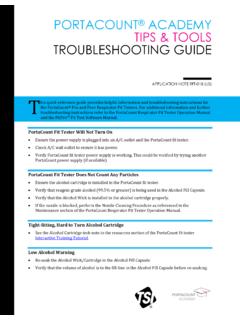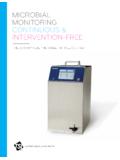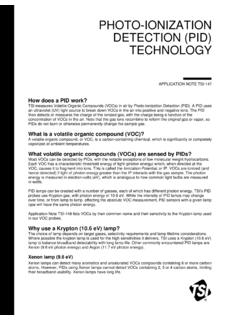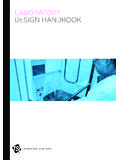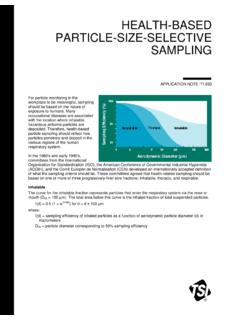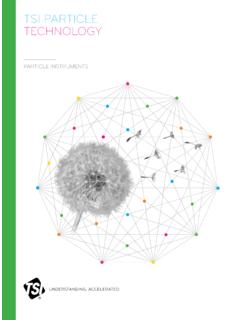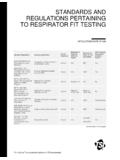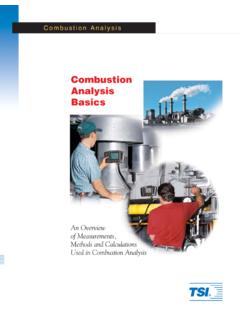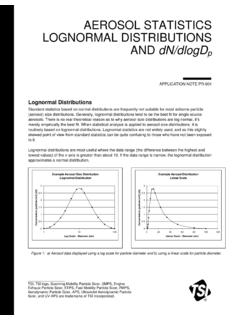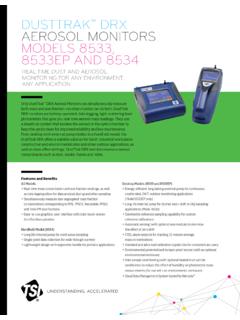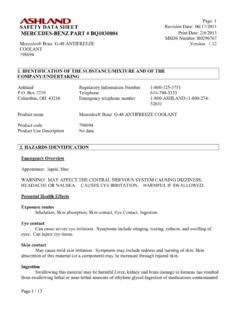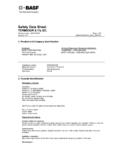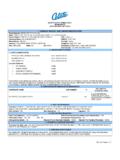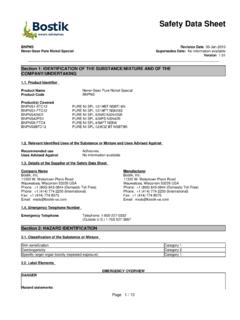Transcription of TSI MSDS 1080546 Rev H Version: 1.2 Revision date: 03-06 ...
1 TSI MSDS 1080546 Rev H. Version: Revision date : 03-06 -2015. safety data sheet . 1. Identification Product identifier: isopropyl Alcohol Other means of identification Product No.: 9088, 5892, 9095, 9084, 9083, 9082, 9079, 9078, 9059, 9055, 9045, 5986, 5978, 5977, 5967, 5873, 5863, 9827, 5373, 9334. Recommended use and restriction on use Recommended use: For use in the PortaCount Respirator Fit Tester Restrictions on use: Not known. Manufacturer/Importer/Supplier/Distribut or information Manufacturer Company Name: TSI Incorporated Address: 500 Cardigan Road Shoreview, MN 55126. Telephone: Customer Service: 800-874-2811. Fax: Contact Person: e-mail: Emergency telephone number: 24 Hour Emergency: 908-859-2151. Chemtrec: 800-424-9300. 2. Hazard(s) identification Hazard classification Physical hazards Flammable liquids Category 2. Health hazards Serious eye damage/eye irritation Category 2A.
2 Specific target organ toxicity - single Category 3. exposure Label elements Hazard symbol: Signal word: Danger Hazard statement: Highly flammable liquid and vapor. Causes serious eye irritation. May cause respiratory irritation. May cause drowsiness or dizziness. SDS_US - SDS000000696 Page 1 of 10. Version: Revision date : 03-06 -2015. Precautionary statement Prevention: Keep away from heat/sparks/open flames/hot surfaces. No smoking. Keep container tightly closed. Ground/bond container and receiving equipment. Use explosion-proof electrical/ventilating/lighting/equipmen t. Use only non- sparking tools. Take precautionary measures against static discharge. Wear protective gloves/protective clothing/eye protection/face protection. Use only outdoors or in a well-ventilated area. Avoid breathing dust/mist/vapors. Wash thoroughly after handling. Response: In case of fire: Use water spray, foam, dry powder or carbon dioxide for extinction.
3 IF INHALED: Remove victim to fresh air and keep at rest in a position comfortable for breathing. Call a POISON CENTER or doctor/physician if you feel unwell. IF ON SKIN (or hair): Remove/take off immediately all contaminated clothing. Rinse skin with water/shower. IF IN. EYES: Rinse cautiously with water for several minutes. Remove contact lenses, if present and easy to do. Continue rinsing. If eye irritation persists: Get medical advice/attention. Storage: Store in a well-ventilated place. Keep cool. Keep container tightly closed. Store locked up. Disposal: Dispose of contents/container to an appropriate treatment and disposal facility in accordance with applicable laws and regulations, and product characteristics at time of disposal. Other hazards which do not result in GHS classification: Static accumulating flammable liquid can become electrostatically charged even in bonded and grounded equipment.
4 Sparks may ignite liquid and vapor. May cause flash fire or explosion. 3. Composition/information on ingredients Substances Common name and CAS. Chemical identity Content in percent (%)*. synonyms number isopropyl ALCOHOL isopropanol 2-propanol, 67-63-0 98 - 100%. sec-propyl alcohol * All concentrations are percent by weight unless ingredient is a gas. Gas concentrations are in percent by volume. 4. First-aid measures General information: Get medical advice/attention if you feel unwell. Show this safety data sheet to the doctor in attendance. Ingestion: Call a physician or poison control center immediately. Do NOT induce vomiting. If vomiting occurs, keep head low so that stomach content doesn't get into the lungs. Inhalation: Move to fresh air. Get medical attention if symptoms persist. Skin contact: Wash skin thoroughly with soap and water. Get medical attention if symptoms occur.
5 Eye contact: Immediately flush with plenty of water for at least 15 minutes. If easy to do, remove contact lenses. Get medical attention. SDS_US - SDS000000696 Page 2 of 10. Version: Revision date : 03-06 -2015. Most important symptoms/effects, acute and delayed Symptoms: Harmful if swallowed. Narcotic effect. Irritating to eyes, respiratory system and skin. Indication of immediate medical attention and special treatment needed Treatment: Treat symptomatically. Symptoms may be delayed. 5. Fire-fighting measures General fire hazards: Highly flammable liquid and vapour. Suitable (and unsuitable) extinguishing media Suitable extinguishing media: Water spray, foam, dry powder or carbon dioxide. Unsuitable extinguishing Avoid water in straight hose stream; will scatter and spread fire. media: Specific hazards arising Vapors may cause a flash fire or ignite explosively.
6 Vapors may travel from the chemical: considerable distance to a source of ignition and flash back. Prevent buildup of vapors or gases to explosive concentrations. Vapor from the solvent may accumulate in container headspace resulting in flammability hazard. Thermal decomposition may release oxides of carbon. Special protective equipment and precautions for firefighters Special fire fighting Use water spray to keep fire-exposed containers cool. Water may be ineffective procedures: in fighting the fire. Fight fire from a protected location. Move containers from fire area if you can do so without risk. Special protective Firefighters must use standard protective equipment including flame equipment for fire-fighters: retardant coat, helmet with face shield, gloves, rubber boots, and in enclosed spaces, SCBA. 6. Accidental release measures Personal precautions, ELIMINATE all ignition sources (no smoking, flares, sparks or flames protective equipment and in immediate area).
7 Keep unauthorized personnel away. Keep emergency procedures: upwind. Use personal protective equipment. Do not touch damaged containers or spilled material unless wearing appropriate protective clothing. Ventilate closed spaces before entering them. See Section 8 of the MSDS for Personal Protective Equipment. Methods and material for Eliminate all ignition sources if safe to do so. Take precautionary containment and cleaning up: measures against static discharges. Stop leak if possible without any risk. Use only non-sparking tools. Absorb spill with vermiculite or other inert material, then place in a container for chemical waste. Clean surface thoroughly to remove residual contamination. Dike far ahead of larger spill for later recovery and disposal. Notification Procedures: Prevent entry into waterways, sewer, basements or confined areas. Inform authorities if large amounts are involved.
8 Environmental precautions: Do not contaminate water sources or sewer. Prevent further leakage or spillage if safe to do so. SDS_US - SDS000000696 Page 3 of 10. Version: Revision date : 03-06 -2015. 7. Handling and storage Precautions for safe handling: DO NOT handle, store or open near an open flame, sources of heat or sources of ignition. Protect material from direct sunlight. Take precautionary measures against static discharges. Ground/bond container and receiving equipment. Use explosion-proof electrical/ventilating/lighting/equipmen t. Use only non-sparking tools. Wear protective gloves/protective clothing/eye protection/face protection. Avoid contact with eyes, skin, and clothing. Use only with adequate ventilation. Wash hands thoroughly after handling. Conditions for safe storage, Keep away from food, drink and animal feeding stuffs. Keep container tightly including any closed in a cool, well-ventilated place.
9 Ground container and transfer incompatibilities: equipment to eliminate static electric sparks. Comply with all national, state, and local codes pertaining to the storage, handling, dispensing, and disposal of flammable liquids. 8. Exposure controls/personal protection Control parameters Occupational exposure limits Chemical identity Type Exposure Limit values Source isopropyl ALCOHOL TWA 200 ppm US. ACGIH Threshold Limit Values (2011). STEL 400 ppm US. ACGIH Threshold Limit Values (2011). REL 400 ppm 980 mg/m3 US. NIOSH: Pocket Guide to Chemical Hazards (2010). STEL 500 ppm 1,225 mg/m3 US. NIOSH: Pocket Guide to Chemical Hazards (2010). PEL 400 ppm 980 mg/m3 US. OSHA Table Z-1 Limits for Air Contaminants (29 CFR ) (02 2006). TWA 400 ppm 980 mg/m3 US. OSHA Table Z-1-A (29 CFR ). (1989). STEL 500 ppm 1,225 mg/m3 US. OSHA Table Z-1-A (29 CFR ). (1989). Biological limit values Chemical identity Exposure Limit values Source isopropyl ALCOHOL 40 mg/l (Urine) ACGIH BEL (2011).
10 (acetone: Sampling time: End of shift at end of work week.). Appropriate engineering Good general ventilation (typically 10 air changes per hour) should be used. controls Ventilation rates should be matched to conditions. If applicable, use process enclosures, local exhaust ventilation, or other engineering controls to maintain airborne levels below recommended exposure limits. If exposure limits have not been established, maintain airborne levels to an acceptable level. An eye wash and safety shower must be available in the immediate work area. Use explosion-proof ventilation equipment. Individual protection measures, such as personal protective equipment Eye/face protection: Wear safety glasses with side shields (or goggles). SDS_US - SDS000000696 Page 4 of 10. Version: Revision date : 03-06 -2015. Skin protection Hand protection: Wear chemical resistant gloves.
